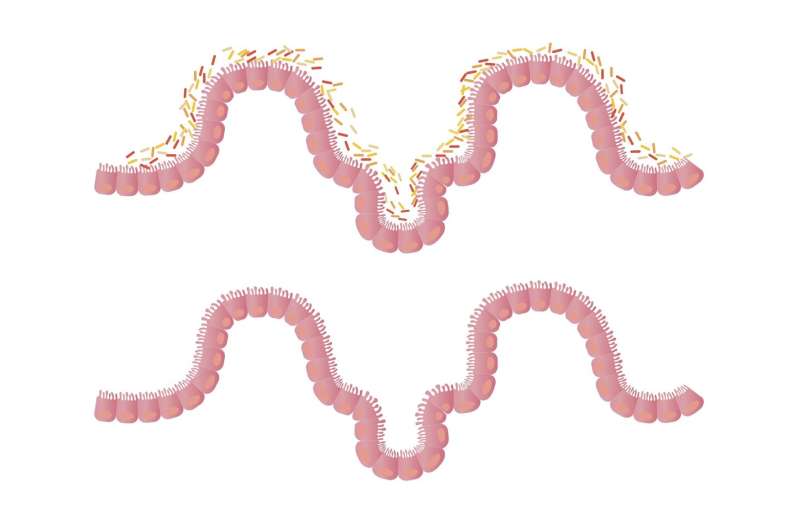
Credit: Pixabay/CC0 Public Domain
Bifidobacterium breve, or B breve for short, is a bacterial species that’s found in the human intestine. It’s especially relevant in early life, being one of the most abundant bacteria in the newborn gut.
B breve is a species of the genus Bifidobacterium and is considered key in the development of a healthy gut. It has been studied extensively over the years to uncover how it benefits us from our first days of life.
Some of the benefits associated with this species include protection against pathogens, modulation of the immune system, and provision of nutrients through the breakdown of non-digestible carbohydrates from the diet.
We’re still learning about the origin of B breve. But vertical transmission, where the origin is the mother and the transfer to the baby occurs either during or after birth, is understood to be the main source of microbes at an early age.
A study carried out by MicrobeMom (a project I was part of during my Ph.D.) has shown that Bifidobacterium strains including B breve are indeed transferred from mother to infant. We didn’t investigate the precise mode of transfer, but one of the key factors influencing the outcome was vaginal birth, so it’s likely these bacteria are passed on during childbirth.
Our research also showed that B breve was the most frequently isolated of the Bifidobacterium species. It was present in vaginal samples from the mother, stool samples from the infant and the mother, as well as breast milk. In fact, B breve represented 80% of the total Bifidobacterium isolated from breast milk.
This highlights the pivotal role that the mother’s gut microbiome has in fostering a baby’s gut health.
Bifidobacterium and the infant gut
Bifidobacterium in general are known for being one of the first colonizers of the infant gut. This is because of their important role degrading carbohydrates from the diet that the infant gut cannot digest.
This has a positive effect not only on the development of the gut but also the baby’s immune system. The mechanism for this is quite complex, but in general terms Bifidobacterium have been shown to interact with human immune cells and to modify immune responses.
The human microbiome changes constantly, and Bifidobacterium is a good example of this. The amount of Bifidobacterium in our gut changes during our lifespan, as does the composition of specific Bifidobacterium species, in response to our diet.
Bifidobacterium is the most abundant bacteria in the first months of life, when a baby is breastfed, and when microbial diversity (the variety of bacteria, viruses and other microbes we carry) is still very low. The microbiota begins to change when solid food is introduced, and we have less Bifidobacterium as we get older when the microbial diversity in our gut increases.
Species such as Bifidobacterium adolescentis and Bifidobacterium longum are typically associated with adulthood, due to their ability to degrade plant-derived carbohydrates found in fruit and vegetables. But B breve and certain other species are generally associated with infancy.
Breast milk
Human milk is a complex fluid capable of satisfying all the nutritional requirements of a newborn. It also provides extensive health benefits, such as reduced risk of various infections. Its composition changes over the period of lactation, adapting to the requirements of the infant.
Breast milk is one of the main factors that influences the infant microbiota, as breastfeeding increases the number of Bifidobacterium in the infant gut.
One specific component of breast milk that affects the composition of the microbiome is human milk oligosaccharides, which are the most abundant carbohydrates present in breast milk after lactose.
These carbohydrates cannot be digested by the human gut, which is where B breve plays an important role. It’s among the microbes that can degrade human milk oligosaccharides, and in this way, they promote its persistence in the gut.
Prebiotics and probiotics
Human milk oligosaccharides are considered prebiotics—carbohydrates, indigestible by the human gut, that promote the growth of beneficial bacteria in the gut, such as B breve.
B breve is regarded as a probiotic—a bacterial species whose intake has a benefit for the host.
Nowadays, human milk oligosaccharides can be found in formula milk, aiming to facilitate the same changes in the microbiota through their prebiotic effects.
B breve is used as a supplement to treat and prevent gastrointestinal problems such as diarrhea, often administered in combination with other probiotic bacteria such Lactobacillus or other Bifidobacterium species. It’s also commercially available in combination with prebiotics.
This article is republished from The Conversation under a Creative Commons license. Read the original article.![]()
Citation:
Gut microbiome: Meet Bifidobacterium breve, keeping babies healthy (2024, March 2)
retrieved 3 March 2024
from https://medicalxpress.com/news/2024-03-gut-microbiome-bifidobacterium-breve-babies.html
This document is subject to copyright. Apart from any fair dealing for the purpose of private study or research, no
part may be reproduced without the written permission. The content is provided for information purposes only.
>>> Read full article>>>
Copyright for syndicated content belongs to the linked Source : Medical Xpress – https://medicalxpress.com/news/2024-03-gut-microbiome-bifidobacterium-breve-babies.html










